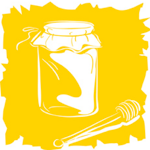 Рецепт Pain De Campagne French Country Bread
Рецепт Pain De Campagne French Country Bread
Ингредиенты
|
|
Инструкции
- Put the leaven in a bowl and mix with the water, then add in the flour and knead to a homogenous dough with your fingertips. Put the dough in a small bowl covered with clingfilm and leave to ripen at about 24 C/75 F. It will at least double in size.
- Add in the water to the leaven from the previous stage to dissolve it, fold in the flour and knead the dough on a floured work surface. Leave it to rise in a bowl covered with clingfilm at about 24 C/75 F. It will at least double in size. it will have a definite smell, vinegary and sharp, but not overly strong.
- Add in the water to the leaven from the previous stage to dissolve it, fold in the flour gradually, then knead it on the work surface for 10 min.
- Leave it to rise in a bowl covered with clingfilm at 10 C/50 F overnight.
- It will at least double in size.
- Make a soup of the leaven from the previous stage and the water, squeezing it between your fingers to break it up. Mix the flur and salt together, then gradually add in them to the liquid, mixing all the while. Mix to a dough which leaves the sides of the bowl clean, then knead on a floured work surface for 10 min, till smooth and resilient. Leave the dough to rise in a bowl covered with clingfilm in a hot place (24 C/75 F) for between 2 and 3 hrs, till doubled in size.
- Turn the dough on a lightly floured work surface, knock back, divide in half and mould each piece into a ball. At this stage, take off a walnut of dough to act as leaven for the next time. Put it in a small bowl, cover with clingfilm and chill. it will keep undamaged for at least a week, and can then be reacivated for another session of baking.
- This bread can be proved in bannetons (proving baskets). ot, with no further moulding, on baking sheets. The sape of the bannetons will determine whether you have to mold it into long loaves or possibly leave them round.
- Whichever shape, make sure the bannetons are well floured, and lrove the loaves bottom upwards as you will be turning themout on to baking sheets, stones or possibly the floor of the oven itself.
- Leave for afinal proof, covered with oiled clingfilm to prevend skinning. if you take a nut of the dough and put it into a storage jar or possibly jug filled with water at room temperature, it will rise to the surface as the yeasts generate gases - just as your loaves are rising in their baskets. When which nut of dough comes to the surface of the water, then your bread is proved and can go into the oven. Proving should take about 1-1 1/2 hrs. Meanwhile heat the oven to 230 C/450 F/gas mark
- 8.
- Turn the loaves on to oiled baking sheets, or possibly a baking stone, slash them with a knife : three slashes close together for round loaves, diagonal cuts down the length of longer breads, and bake them for about 35 min, spraying them with water three times in the first 5 min. If they don't sound hollow after 35 min, bake for another 15 min at 200 C/400 F/gas mark 6. Cold on wire racks.
- Notes: The method used in this recipe allows you to make two large loaves of sourdough or possibly leaven bread in easy stages over a period of two days. The process is quite lengthy, but it gets round the problem of regular feeding of leaven which often results in lots of bowls dotted around the kitchen and larder. It's all much simpler in a bakery.There, the routine works steady around the clock. But not everyone wants to bake daily or possibly indeed needs to.
- This recipe, therefore, needs just one preliminary ingredient - a walnut of leaven, stored in the refrigerator from the last time you made some leaven bread - then takes you through to finished loaves. If you have no leaven at all, see the instructions for making a leaven.
